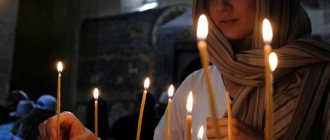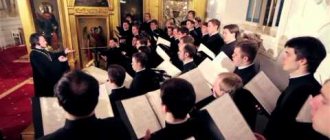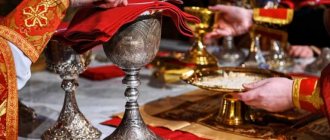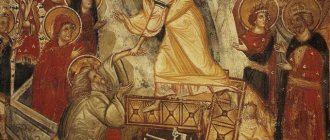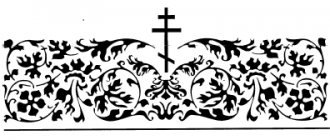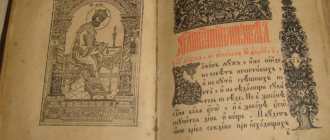Why you should pray
The classic prayer book is the main source of complete prayers used by generations of believers. Canons vary in content and content:
- for priests;
- for ordinary believers;
- about sick people;
- about religion;
- for mothers with prayers for children;
- about the world;
- about the fight against passions;
- in Russian and Church Slavonic languages.
The prayer book contains very strong prayers to the Savior, the Mother of God, and the patron saints. All words have been passed down for centuries and therefore have a powerful effect. Many of the prayers are transmitted in Old Church Slavonic, and for correct pronunciation they are accented.
Mandatory holy appeals that should be in the prayer book include:
- Morning and evening. Read after waking up and before going to bed.
- Daytime. They are pronounced before eating and at the end of a meal, before business and training.
- Canons for every day of the week and holidays.
- "Canon of repentance to our Lord Jesus Christ."
- Akathists. They include a huge list, but the most important ones are the Most Holy Theotokos, Jesus Christ, St. Nicholas and the holy protectors to whom you want to pray.
- “Following to Holy Communion.”
God is often addressed in the words of sacred texts, but you can also speak in your own words, especially if you need to ask for something. They can be said at home with family or on your own. Before turning to the Savior, they read “Our Father” and then speak in their own words. Be sure to perform the sign of the cross.
You cannot ask for punishment, wish bad or evil for another person.
Orthodox Life
At the beginning of the material, it is worth immediately making a reservation that we will talk about the canons of prayer, and not about the canons - church rules.
To understand what canons are, you need to understand the etymology (origin) of the word “canon”. This word originated in the Hellenistic world of antiquity and its usage is very extensive. It means “rule, standard.” The word itself came from the construction industry, where “canon” was a certain measure - an ancient plumb line or ruler.
That is, a canon is something unshakable, compositionally clear and always the same. A canon is an axiom that does not require proof. Something that goes without saying.
The use of the word "canon" is very broad. Church canons are normative rules of behavior based on dogmas. Canon of the Books of Holy Scripture of the Old and New Testaments. He is always alone, nothing can be added to him, and nothing can be taken away from this canon. Canons (laws) of art, certain codes and rules by which art exists. The word "canon" was also used in medicine.
This word is used widely in Orthodox liturgics and hymnography. Canons are long prayers that have a very clear, compositionally complete structure. These prayers form an important part of both public church services and private (cell, home) prayer.
History of the creation of canons
Already the first Christians in their services tried to combine Old Testament liturgical texts known from ancient times (mainly psalms and biblical songs) with prayers of New Testament content. Archimandrite Cyprian (Kern) writes about this (about the canons) in his book “Liturgics”: “This is a complex chain of different Old Testament hymns intertwined with Christian chants.” The genre developed by the 8th–9th centuries. Canons as a liturgical genre replaced earlier kontakia. Why this happened is not known exactly, but Byzantine hymn-makers began to introduce canons into divine services instead of the more well-known kontakia in the 6th century (extensive works somewhat vaguely reminiscent of akathists, of which today only a short prayer book called “kontakion” remains). And today, at Matins in Orthodox worship, it is the canons that are used, occupying more than half of its time.
Canon structure
As mentioned above, the canon is a prayer work consisting of prayers of the Old Testament and New Testament content, which are united around the figure of our Lord Jesus Christ, shown in the canon as the Savior of Humanity. It is the Redemptive Feat of the God-Man to save people that is the center of the plot of any canon, regardless of who it is dedicated to: the Lord God, the Most Holy Theotokos, a holiday or a saint.
Four components of the canon can be distinguished:
1. Irmos. 2. Troparion. 3. Chorus. 4. Prayer.
Also, for the third and sixth songs, short chants are used: kontakia, ikos, sedalny, which also have as their goal the glorification of God (the Most Holy Theotokos, the saint) and the mood of the human soul for repentance. The canon always has nine large parts, they are called songs - nine songs.
Irmos
The word “irmos” itself is translated from Greek as “connection, plexus, row.” And indeed: this is a work that is sung, as if connecting and connecting songs. There are nine irmos in total, as well as songs. The songs begin with them. And if the troparia are then mainly read, then the irmos are sung in chorus. In addition to the irmos of the ninth canto, which tells us about the Most Holy Theotokos and the incarnation, the incarnation through Her Lord and our God Jesus Christ into the world. The previous eight irmos represent Old Testament events or prophecies laid out in a chronological order (from the oldest to the newest) about the Savior of the world, Christ. To one degree or another, they represent the incarnation of the Son of God to deliver all people from slavery to the devil, death, and sin. And that’s why Irmos are always very solemn. They have an Easter or Christmas coloring.
The first irmos is the event of the Old Testament Passover - the deliverance of the Jews through the holy prophet Moses from Egyptian captivity. This is Moses' song of thanksgiving to God or variations on its theme for the fact that the Most High led the people of Israel through the Red Sea (Ex. 14:21–15:21). This event, of course, prefigures the Resurrection of Christ: the deliverance of all mankind from slavery to Satan and the opening of the road to paradise by Christ.
The second canto is virtually absent. After the first, the third song is sung immediately. The second hymn appears only during Great Lent (for example, in the Great Penitential Canon of St. Andrew of Crete). And during other Lenten services. Its original authorship also belongs to the holy prophet Moses. It has the repentant, mournful character of the prophet’s denunciation of the Jewish people of wickedness. Due to its penitential, mournful nature, the song appears during services only during the Holy Pentecost period. Irmos of the third song is a variation on the theme of the song of thanksgiving to the holy righteous Anna, mother of the prophet Samuel. She didn't have children for a long time. She asked God to send her a child, and the woman would dedicate him to God. Anna gave birth to the great prophet Samuel. And so, in gratitude for this gift, the saint sang her song to the Lord (1 Sam. 2:1-10). Of course, there is also a symbol of the Nativity of Christ. The merciful Creator will send His Only Begotten Son into the world to save people suffering from sin.
The Irmos of the fourth and fifth songs are prophetic. They represent the songs of the holy prophets, who also sang of the coming coming of Christ into the world and His salvation of people. The Irmos of the fourth song is the prayer of the prophet Habakkuk (Hab. 3:1-19), the fifth is the song of the prophet Isaiah (Is. 26:9-19).
Irmos of the sixth canto tells us about the prayer of thanksgiving of the holy prophet Jonah, when the Lord delivered him from the belly of the whale. Here, of course, there is also a prophetic symbol of our Lord Jesus Christ Himself, when He said: “... And no sign will be given to him except the sign of the prophet Jonah; For as Jonah was in the belly of the whale three days and three nights, so will the Son of Man be in the heart of the earth three days and three nights” (Matthew 12:39, 40). And here the Savior speaks about His future suffering on the cross, Resurrection and descent into hell. Therefore, there is something solemn and Easter in this Irmos. This Easter meaning is deeply and fully reflected precisely in the irmos of the sixth song of the Easter canon:
“Thou hast descended into the depths of the earth and shattered the eternal faiths that contain those bound, O Christ, and thou hast lived three days like Jonah from the whale; thou hast risen from the grave.”
The theme of the Holy Resurrection of Christ is continued by the irmos of the seventh and eighth songs of the canon. They tell the story of the Jewish youths Hanani, Asariah and Mishael, whom King Nebuchadnezzar threw into a fiery furnace because the righteous did not want to worship a pagan idol. But the Angel of God turned the fire into dew and left the pious young men in the fire alive and completely unharmed. The above irmos are dedicated to this topic. And, of course, here there is also a symbol of the Redemptive Feat of our Lord Jesus Christ: the machinations of the devil, the shackles of sin and death itself - all this fierce fire will not harm a person if God is with him, Who leads him to peace, to the Kingdom of Heaven.
And finally, the Irmos of the ninth canto, which is always the Mother of God and always says that through the Virgin Mary, the Second Person of the Holy Trinity, God the Son, became man for the salvation of mankind.
All these nine irmos are stages of Sacred history and reveal to those praying with faith the great miracle of God’s salvation of fallen people.
Troparions, choruses, prayer
The main content of the canons is, of course, troparia. They have predominantly New Testament content. And they already tell us about the event being celebrated or about the life of the saint to whom the service is dedicated on this day.
You can often see at all-night vigils how people, after polyeleos and anointing, go home. It is not right. After all, the main memory of the day, the main information about it, the deep revelation of the meaning of the celebrated event occurs just after - in the canons. They represent a kind of extended “nine-episode film” that reveals to us the wondrous secrets of God’s economy, revealing to our souls the amazing miracles of the Lord’s salvation of fallen humanity. Therefore, of course, it is necessary to turn aloud when reading the canons at Matins and listen to this Divine verb, enlightening and revitalizing the depths of our hearts, like a healing spring of the heavenly grace of the Holy Spirit.
The choruses and prayer are always dedicated to the Lord, the Most Holy Theotokos or the saint to whom the canon is read. For example, on the Great Penitential Canon of St. Andrew of Crete, the chorus is “Have mercy on me, O God, have mercy on me.” If the canon is to the Most Holy Theotokos, then the chorus is “Most Holy Theotokos, save us.” If to a saint, for example, the Great Martyr George the Victorious, then “Holy Great Martyr George, pray to God for us.”
The penultimate troparion is always dedicated to the Most Holy Trinity. Therefore, the chorus to it is: “Glory to the Father and the Son and the Holy Spirit,” and the last one is always to the Most Holy Theotokos. The chorus to it is “And now, and ever, and unto ages of ages. Amen". Again, the last troparion speaks of the Mother of God because through Her the Messiah became incarnate and became human into the world. This troparion is also often inscribed in liturgical literature as “Theotokos.” The Holy Fathers decided to add “Theotokos” to the end of each song of each canon during the era of the Third and Fourth Ecumenical Councils, when the struggle against the heresy of Nestorianism took place. Heretics argued that the Virgin Mary gave birth not to God, but to Christ the man, and therefore She should be called “Christ Mother.” In order to eradicate this heresy, the holy fathers decided to sing at the end of each song of any canon “Theotokos”, glorifying the Most Pure One precisely as the Most Holy Theotokos - the Mother of God, Who gave birth to our God and Savior Jesus Christ.
The canons are a very important part of worship, both church and home. Therefore, you should not neglect them. Do not think of them as an intermission in the theater between the polyeleos and the great doxology. Do not languish over them while preparing for the communion of the Body and Blood of Christ. But it’s better to stop, give them time, read them, and through these pure and fiery words the laws of the Kingdom of Heaven and the life of the human soul in the grace of the Holy Spirit will be revealed to you. A treasure will be revealed to you!
Archpriest Andrey Chizhenko
Contents of the prayer rule
The prayer rule includes morning prayers, as well as those read before bed. Words can always be found in prayer books. There are 3 main prayer rules:
- Complete. Intended for priests and church ministers.
- A short. For all Orthodox Christians.
- Short Seraphim of Sarov.
The prayer rule is recommended to be read by the whole family, but it can also be read individually. General reading is advisable on holidays, memorable dates, and on the eve of special events.
Recommended prayers for home reading:
- "Our Father";
- laudatory to glorify God;
- thanks for help, patronage and intercession;
- before starting business;
- requests for healing, protection, help;
- repentance, in which one repents of sins, words and actions;
- before eating.
Time and place for prayers
The best place for prayer at home is a prayer corner. It is located in a quiet, secluded place. The special atmosphere that reigns in the God-pleasing space inspires reverence and encourages prayer.
Morning and evening hours are the best time to talk with the Savior. In the morning it is better to get up early and not rush anywhere, spending time with God. Before going to bed, it is also important to pray and go to rest with peace of mind. They pray on weekdays and holidays, memorable and solemn dates. They pray, if their heart dictates, with concern for loved ones.
Sequence of Spiritual Worship
Before starting the prayer, they retire and light a lamp. They stand in front of the holy image. It is advisable to learn the main texts by heart. The five main ones are listed below:
- "Our Father";
- "King of Heaven";
- “Virgin Mother of God, rejoice”;
- “It is worthy to eat”;
- "Symbol of faith".
They perform prostrations and bows to the ground and make the sign of the cross. You should not be afraid if prayer is difficult; often this is proof of true effectiveness.
Preparation rules
You should prepare for prayer, for which there are certain rules:
- They come to God washed, combed, and dressed in fresh clothes.
- Women should wear a headscarf and a long skirt.
- They approach the holy image with reverence.
- If there is no icon, it is allowed to be located near the windows on the east side.
- Light a lamp or candle.
- Kneel or straight, the position should be natural.
- During prayer, they try to concentrate on a conversation with God or a saint.
Reading Features
The main thing is faith, on the basis of it any prayer is possible. Repentance for sins from the heart is one of the components. It is important to ask forgiveness from your loved ones, forgive yourself and let go of grievances. In this case, there is a high probability of being heard by God.
The words of the prayer are said slowly, preferably out loud or in a whisper. Focus on the spoken words and speak from the heart. If necessary, repent of sins. Each line is passed through the soul, they comprehend what is said. Before pronouncing words, perform 3 prostrations and 3 signs of the cross.
You can start with the “Our Father”, and then read the “Prayer Book” or use your own words.
How to end prayers
At the end, they offer praise and gratitude to God. Be sure to cross yourself three times with the sign of the cross. After prayer, you can study, go to work, and do household chores. It is better not to quarrel with anyone and not to offend others.
Real story
In the practice of one fairly well-known modern priest, there are many real cases where reading the Canon of Penitence for even six months turned the life of the worshiper and his loved ones in the most favorable direction.
One day, a woman who was dying of cancer was brought to a priest for guidance and advice on how to live. They led her by the arms into the holy temple of the Lord and brought her to the priest. She told him that she was dying and that none of the doctors could help her. During the conversation, it became clear that at one time this woman had committed a lot of abortions in her youth, and this was not consciously understood by her as a mortal sin of murder, moreover, of her own children. Father explained to her the scale of what she had done and called everything by its proper name.
The woman asked what she should do, because the dead cannot be returned. The priest blessed her to read the Canon of Repentance every day for her deeds, to try to dispose her soul to sincere repentance and change, to invite the priest more often for confession and communion if she herself is not able to come to church. This was the end of the conversation.
A year later, according to the priest’s story, at the time of the service, a fresh-looking middle-aged but pretty smiling woman in a hat entered the church where the fateful conversation took place. She was looking for someone in the crowd. When she saw the priest, she joyfully approached him, took the blessing and began to thank him. He did not immediately recognize her as the woman who a year ago, dying, was brought under his arms for what was most likely the last conversation.
It turned out that upon arriving home, where the doctors had discharged her to die, she began to fulfill the blessing exactly: she read the canon every day, tried to induce repentance in herself, diligently confessed and received communion. Six months later, she no longer needed support from relatives, began to go to church on her own, her appetite improved, and the cancer receded. But that is not all. During this year, both of her daughters met their love, things improved, and so many favorable events happened in their lives that had not happened throughout their lives. The Lord joyfully accepted the repentant and hastened to bestow both her and her loved ones with His rich mercies.
What to do when scattered
Often, when reading holy texts, all sorts of thoughts and ideas slip into your head. One of the reasons is fatigue. You need to try to tune in to prayer and not be interrupted.
It is useful to pray through strength, directing thoughts in the right direction. Since the brain does not always perceive the power of the word, everything passes through the soul and leaves divine grace in it.
In order not to be distracted during the time of conversion through prayer, it is advisable to retire, otherwise it will be difficult for God or the saints to hear you. This way you can concentrate and open up better.
Theophan the Recluse advises following a simple rule when preparing for prayer: walk around and think before addressing the greatness of the one to whom you are going to address, comprehend who God is and who you are. Such an internal attitude will allow reverent fear and reverence to be revived in the soul.
The power of prayer is priceless and can work miracles. By sincerely praying, it is possible to change fate, beg for healing, health.
If you find an error, please select a piece of text and press Ctrl+Enter.
The Penitential Canon in Everyday Life
Reading about the repentant prayer to the Lord God, only from the point of view of preparation for the Sacrament of Repentance (confession), it is impossible to know all the possibilities of this small prayer service. In modern spiritual practice, priests often resort to the advice of reading this rule when a person is in various difficult states:
- in case of serious troubles;
- in illness;
- in sorrows and sorrows;
- in the absence of children;
- with difficulties in personal and family life.
Most often, this rule is suggested to be read in case of health problems. If we consider that all the troubles and misfortunes happen to us because of our own sins, even seemingly causeless anger on the part of others, then bringing our disposition to repentance to God inclines the Lord to mercy.
